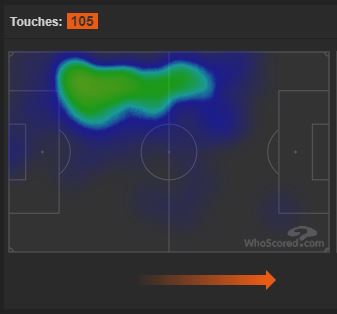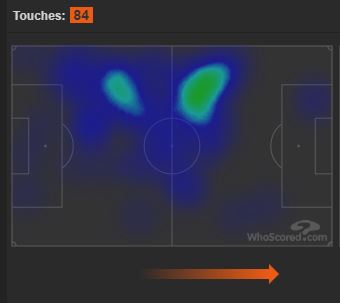Prior to Arsenal’s mid-winter break, they had struggled to convert dominance into goals. In five of Arteta’s first eight games in charge they had not scored more than once. The new coach quickly set about stabilising a defence that had become the by-word for instability, but arguably at the cost of a more prolific attack.
This run culminated in a dreary 0-0 draw at Burnley where the team’s offensive firepower seemed to dwindle as the game went on. The mid-winter training camp in Dubai gave Arteta a valuable opportunity to take stock and I am certain that making his team more clinical in attack will have been uppermost in his mind.
Since returning from the emirate, Arsenal have won three games in a row, scoring eight goals in the process. In his pre-Newcastle press conference, Arteta said, “I have tried to convince the players that if we work on certain things in training, they will happen in games and we will score goals from them.” Then after the subsequent 4-0 win, he told the press, “We talked about turning those draws into wins and those margins that we could improve to translate that into more points.”
Improving the team’s attacking output was almost certainly at the top of his agenda for the winter training camp, so how have Arsenal managed it in the last three matches? The first thing to say is that there are plenty of ‘soft factors’ at play. Alex Lacazette was in a poor period of form, individually speaking and he managed to break that spell with a pretty fortuitous finish against Newcastle.
It is difficult to consider this a tactical triumph on the part of the coach; it seemed to be more of a mental block for the Frenchman and one he seems to have cleared. Without the serendipitous goal against Newcastle, he probably doesn’t score in Athens four days later. Maybe there is something to be said for the democratic environment Arteta has created.
The manager has started Eddie Nketiah upfront in the two most recent Premier League games and the Burnley game seems to have convinced him that Aubameyang and Martinelli want to play the same sort of role in a similar fashion and, ergo, probably can’t play together. Arteta will probably reflect that he made a mistake selecting the Brazilian on the right of the attack with Aubameyang on the left at Turf Moor, that front-line lacked synergy.
When explaining his decision to select Nketiah ahead of Lacazette, Arteta said, “The message is very clear, whoever trains like they do and I see that they have the abilities, the quality and their hunger like he’s done to perform today, he’s got a chance to play. Laca has been playing all the games with me, he hasn’t scored and I told him the decision why and he accepted really well.”
It’s impossible to say whether that conversation with Lacazette contributed to the end of his personal drought, of course. It is likely several parts a happy coincidence that was going to arrive at some point. One also must acknowledge that the Newcastle home fixture represented an easing of the fixture list; it was the first home match against a team from the bottom half of the table since Arteta’s appointment and he was able to select a suitably adventurous starting line-up.
Arsenal also had Pierre Emerick Aubameyang suspended for three games in January, though they scored in each of those games. In Arteta’s attacking setup, inside-left is the corridor of opportunity, wedged between Lacazette / Nketiah’s hard working pivot role and Bukayo Saka’s raiding runs, the inside-left is the one that makes the runs and sniffs the chances. That’s part of the reason Martinelli shone in Aubameyang’s absence and hasn’t been able to since his return.
Moving the ball more quickly seems to have become a priority in the last three games too. The introduction of Dani Ceballos in the midfield double pivot has been key to this. He is naturally a swift recycler of possession, applying garnish to his passes as he whips them into teammates’ feet. The coach has also kept faith with Shkodran Mustafi at centre-half alongside David Luiz, with Sokratis dropping to the bench.
This is clearly due to Mustafi’s superior passing skills. The German is able to play long diagonal passes out of defence and break lines with balls into feet too. Sokratis does not have either of these qualities, even if he is probably a better pure defender. By adding Ceballos to his preference for Mustafi, Arteta has gradually added better ball players to the deeper compartments of his team to get the ball moving more swiftly.
In turn, this has increased Özil’s influence on games, which had begun to sag considerably by the time the winter break came around. For the midweek trip to Olympiacos, Mikel cooled his jets a little when it came to his team selection. He preferred Guendouzi in central midfield to Ceballos and opted for Sokratis at right-back, while Nicolas Pepe sat on the bench.
This suggested a slightly more cautious approach against a team who are very confident on their home ground. His priority was not to allow the Greek side an early lead and a chance to set the tone for the tie. When Everton came to town on Sunday, Arteta again opted for Ceballos in the deeper midfield role and Pepe came in for the more workmanlike Martinelli.
One of the more subtle key changes since the winter break has been the deployment of Granit Xhaka. In Arteta’s first eight games, Xhaka played as a kind of hybrid midfielder-cum-full-back role, nestling in the space Bukayo Saka vacates when he rummages down the left flank. Against Sheffield United at home in mid-January, Xhaka was so deep that he virtually played as a left-sided centre-half.
Since the Dubai training camp, Xhaka has still very much favoured the left side of the pitch and he still provides protection for Saka, but he has done so from a more orthodox base. He has switched from a deputy left-back who occasionally wanders into midfield to a left sided central midfielder who will veer left to guard the back door when necessary.



A look at his heatmaps for the draw with Sheffield United, compared to the positions he took up at home to Newcastle and Everton demonstrate this. With two adept passers in the centre-half position, there is less of a need for Xhaka to build from the deepest recesses of the pitch and Arteta has been a little bolder with his positioning, pushing him slightly higher up the field. That has helped to make the Gunners a slightly more aggressive outfit [we saw against Everton that came at the cost of some defensive security).
It’s too early to suggest that these changes are long or even medium-term features. Newcastle are one of the least threatening offensive teams in the division and having fallen behind in the opening seconds against Everton, Arsenal had to chase the game a little, which may have altered some of the team’s original intentions. However, there is also evidence of some fiddling under the bonnet to get Arsenal’s attacking engine purring.
Follow me on Twitter @Stillberto– or like my page on Facebook


